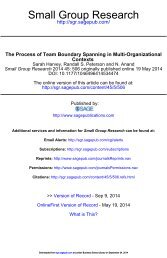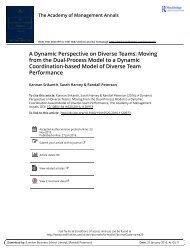Group Dynamics in Top Management Teams: Groupthink, Vigilance, and Alternative Models of Organizational Failure and Success
This study explored the heuristic value of Janis’ (1982) groupthink and vigilant decision making models as explanations of failure and success in top management team decision making using the Organizational Group Dynamics Q-sort (GDQ). Top management teams of seven Fortune 500 companies were examined at two historical junctures—one when the team was successful (defined as satisfying strategic constituencies) and one when the team was unsuccessful. Results strongly supported the notion that a group’s decision making process is systematically related to the outcomes experienced by the team. Ideal-type Q-sorts organized around Janis’ analysis of groupthink and vigilance were substantially correlated with Q-sorts of failing and successful groups, respectively. The fit was, however, far from perfect. Ideal type Q-sorts derived from other frameworks correlated better with the failure–success classification than did the Janis-derived ideal types. Successful groups showed some indicators of groupthink (e.g., risk-taking, cohesion, and strong, opinionated leaders), whereas unsuccessful groups showed signs of vigilance (e.g., internal debate to the point of factionalism). The results illustrate the usefulness of the GDQ for developing and empirically testing theory in organizational behavior from historical cases.
This study explored the heuristic value of Janis’ (1982) groupthink
and vigilant decision making models as explanations of
failure and success in top management team decision making
using the Organizational Group Dynamics Q-sort (GDQ). Top
management teams of seven Fortune 500 companies were examined
at two historical junctures—one when the team was successful
(defined as satisfying strategic constituencies) and one when the team was unsuccessful. Results strongly supported the notion
that a group’s decision making process is systematically related
to the outcomes experienced by the team. Ideal-type Q-sorts organized
around Janis’ analysis of groupthink and vigilance were
substantially correlated with Q-sorts of failing and successful
groups, respectively. The fit was, however, far from perfect. Ideal type
Q-sorts derived from other frameworks correlated better
with the failure–success classification than did the Janis-derived
ideal types. Successful groups showed some indicators of groupthink
(e.g., risk-taking, cohesion, and strong, opinionated leaders),
whereas unsuccessful groups showed signs of vigilance (e.g.,
internal debate to the point of factionalism). The results illustrate
the usefulness of the GDQ for developing and empirically testing
theory in organizational behavior from historical cases.
- No tags were found...
You also want an ePaper? Increase the reach of your titles
YUMPU automatically turns print PDFs into web optimized ePapers that Google loves.
274 PETERSON ET AL.<br />
Another measure <strong>of</strong> the success <strong>of</strong> the groupth<strong>in</strong>k model is the empirical<br />
work it has <strong>in</strong>spired (see Park, 1990). These studies <strong>in</strong>clude experimental<br />
<strong>in</strong>vestigations <strong>of</strong> group cohesiveness <strong>and</strong> leader directiveness (i.e., Flowers,<br />
1977), archival analyses <strong>of</strong> public statements (Tetlock, 1979), case studies <strong>of</strong><br />
historical events blamed on groupth<strong>in</strong>k (e.g., Esser & L<strong>in</strong>doerfer, 1989), <strong>and</strong><br />
quantitative comparisons <strong>of</strong> historical case studies (i.e., Tetlock, Peterson,<br />
McGuire, Chang, & Feld, 1992).<br />
Yet another measure <strong>of</strong> success—albeit a perverse <strong>in</strong>dicator—is the amount<br />
<strong>of</strong> criticism directed at the groupth<strong>in</strong>k model. A great deal <strong>of</strong> attention has<br />
been focused on the underly<strong>in</strong>g theoretical contentions <strong>of</strong> the model. Revisions<br />
<strong>of</strong> the groupth<strong>in</strong>k model have been suggested by Fischh<strong>of</strong>f <strong>and</strong> Beyth-Marom<br />
(1978), Longley & Pruitt (1980), McCauley (1989). Ste<strong>in</strong>er (1982), Turner, Probasco,<br />
Pratkanis, <strong>and</strong> Leve (1992); t’ Hart (1991), <strong>and</strong> Whyte (1989). Recommendations<br />
have <strong>in</strong>cluded dropp<strong>in</strong>g, add<strong>in</strong>g, <strong>and</strong> clarify<strong>in</strong>g various constructs <strong>in</strong><br />
the model. More specifically, critics <strong>of</strong> groupth<strong>in</strong>k have objected to groupth<strong>in</strong>k<br />
on the grounds that, (a) key constructs <strong>in</strong> the model are under- or misspecified,<br />
(b) the strong positive relationship between “good” group process <strong>and</strong> desirable<br />
outcomes is grossly overstated, <strong>and</strong> (c) the facts <strong>of</strong> important historical episodes<br />
have been distorted <strong>in</strong> the dichotomous classification <strong>of</strong> groups.<br />
The current study focuses on an issue that has received relatively less attention<br />
<strong>in</strong> the literature—the heuristic value <strong>of</strong> Janis’ (1982) dist<strong>in</strong>ction between<br />
groupth<strong>in</strong>k as a pathway to failure <strong>and</strong> vigilant decision mak<strong>in</strong>g as the antidote<br />
to groupth<strong>in</strong>k (<strong>and</strong> as a general pathway to success) <strong>and</strong> their application to<br />
top management team decision mak<strong>in</strong>g. A primary goal <strong>of</strong> this research was<br />
to test the usefulness <strong>of</strong> a variety <strong>of</strong> theoretical perspectives <strong>in</strong> expla<strong>in</strong><strong>in</strong>g<br />
success <strong>and</strong> failure <strong>in</strong> a wider “conceptual universe” <strong>of</strong> case studies than that<br />
<strong>of</strong>fered by Janis. Key questions become: How <strong>in</strong>structive is the model for expla<strong>in</strong><strong>in</strong>g<br />
success <strong>and</strong> failure generally? Is groupth<strong>in</strong>k a widespread cause <strong>of</strong><br />
organizational failure or is it a special case? Can other theories expla<strong>in</strong> top<br />
management team failure better than groupth<strong>in</strong>k <strong>and</strong> success better than<br />
vigilant decision mak<strong>in</strong>g?<br />
VIGILANT DECISION MAKING<br />
Janis (1982) contrasted the groupth<strong>in</strong>k fiascoes with the successes <strong>of</strong> groups<br />
that employed vigilant decision mak<strong>in</strong>g (see also Janis & Mann, 1977, 1992).<br />
Vigilant decision mak<strong>in</strong>g was designed to encourage deliberation, use <strong>of</strong> statistical<br />
<strong>and</strong> technical processes, <strong>and</strong> extensive process<strong>in</strong>g <strong>of</strong> <strong>in</strong>formation <strong>in</strong> group<br />
decision mak<strong>in</strong>g. To be “vigilant” <strong>in</strong> decision mak<strong>in</strong>g, groups are required to<br />
carefully survey their objectives, conduct an extensive <strong>and</strong> dispassionate search<br />
for relevant <strong>in</strong>formation, <strong>and</strong> make cont<strong>in</strong>gency plans once an option has been<br />
selected. Specific advice for leaders <strong>in</strong>cludes both accept<strong>in</strong>g criticism <strong>of</strong> her or<br />
his own judgments openly <strong>and</strong> display<strong>in</strong>g impartiality by withhold<strong>in</strong>g policy<br />
preferences at the outset <strong>of</strong> the group discussions (Janis, 1982).<br />
Vigilant decision mak<strong>in</strong>g has been cited as a primary contributor to the<br />
Marshall committee’s success <strong>in</strong> plann<strong>in</strong>g the rebuild<strong>in</strong>g <strong>of</strong> Europe after World

















